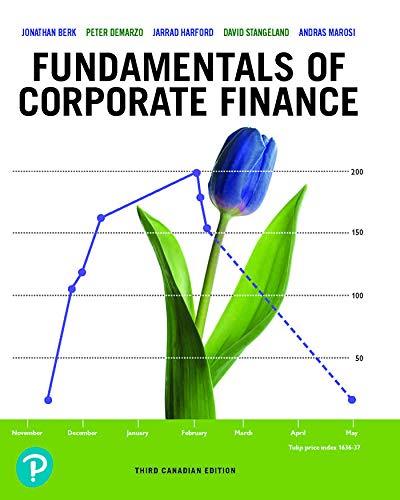
(Computing the standard deviation for a portfolio of two risky investments) Mary Guilott recently graduated from college and is evaluating an investment in two companies' common stock. She has collected the following information about the common stock of Finn A and Firm B: a. If Mary decides to invest 10 percent of her money in Firm A's common stock and 90 percent in Firm B's common stock, what is the expected rate of return and the standard deviation of the portfolio return? b. If Mary decides to invest 90 percent of her money in Firm A's common stock and 10 percent in Firm B's common stock, what is the expected rate of retum and the standard deviation of the portfolio return? c. Recompute your responses to both questions a and b, where the correlation between the two firms' stock returns is -0.30. d. Summarize what your analysis tells you about portfolio risk when combining risky assets in a portfolio. A's common stock and 90% in Firm B's common stock and the correlation coefficient between the two stocks is 0.30, then the expected rate of retum in the portfolio is %. (Round to two a. If Mary decides to invest 10% of her money in Fim decimal places.) The standard deviation in the portfolio is %. (Round to two decimal places) %. {Round to two b. If Mary decides to invest 90% of her money in Firm A's common stock and 10% in Fimm B's common stock and the correlation coefficient between the two stocks is 0.30, then the expected rate of return in the portfolio is decimal places.) The standard deviation in the portfolio is %. (Round to two decimal places.) %. (Round to two c. If Mary decides to invest 10% of her money in Firm A's common stock and 90% in Firm B's common stock and the correlation coefficient between the two stocks is -0.30, then the expected rate of retum in the portfolio is decimal places.) The standard deviation in the portfolio is %. (Round to two decimal places.) %. (Round to two If Mary decides to invest 90% of her money in Firm A's common stock and 10% in Firm B's common stock and the correlation coefficient between the two slocks is -0.30, then the expected rate of return in the portfolio is decimal places.) The standard deviation of the portfolio is %. (Round to two decimal places.) i Data Table d. What does your analysis tell you about portfolio risk when combining risky assets in a por also be lowered by investing a higher O A. You can maintain the same return in a portfolio but lower risk more if the stocks are pl proportion of the portfolio in stock with lower standard deviation, this however will red Expected Returns 0.14 0.11 0.30 Standard Deviation 0.12 0.04 Firm A's common stock Firm B's common stock Correlation coefficient Click to select your answer(s). Print Done (Computing the standard deviation for a portfolio of two risky investments) Mary Guilott recently graduated from college and is evaluating an investment in two companies' common stock. She has collected the following information about the common stock of Finn A and Firm B: a. If Mary decides to invest 10 percent of her money in Firm A's common stock and 90 percent in Firm B's common stock, what is the expected rate of return and the standard deviation of the portfolio return? b. If Mary decides to invest 90 percent of her money in Firm A's common stock and 10 percent in Firm B's common stock, what is the expected rate of retum and the standard deviation of the portfolio return? c. Recompute your responses to both questions a and b, where the correlation between the two firms' stock returns is -0.30. d. Summarize what your analysis tells you about portfolio risk when combining risky assets in a portfolio. A's common stock and 90% in Firm B's common stock and the correlation coefficient between the two stocks is 0.30, then the expected rate of retum in the portfolio is %. (Round to two a. If Mary decides to invest 10% of her money in Fim decimal places.) The standard deviation in the portfolio is %. (Round to two decimal places) %. {Round to two b. If Mary decides to invest 90% of her money in Firm A's common stock and 10% in Fimm B's common stock and the correlation coefficient between the two stocks is 0.30, then the expected rate of return in the portfolio is decimal places.) The standard deviation in the portfolio is %. (Round to two decimal places.) %. (Round to two c. If Mary decides to invest 10% of her money in Firm A's common stock and 90% in Firm B's common stock and the correlation coefficient between the two stocks is -0.30, then the expected rate of retum in the portfolio is decimal places.) The standard deviation in the portfolio is %. (Round to two decimal places.) %. (Round to two If Mary decides to invest 90% of her money in Firm A's common stock and 10% in Firm B's common stock and the correlation coefficient between the two slocks is -0.30, then the expected rate of return in the portfolio is decimal places.) The standard deviation of the portfolio is %. (Round to two decimal places.) i Data Table d. What does your analysis tell you about portfolio risk when combining risky assets in a por also be lowered by investing a higher O A. You can maintain the same return in a portfolio but lower risk more if the stocks are pl proportion of the portfolio in stock with lower standard deviation, this however will red Expected Returns 0.14 0.11 0.30 Standard Deviation 0.12 0.04 Firm A's common stock Firm B's common stock Correlation coefficient Click to select your answer(s). Print Done







